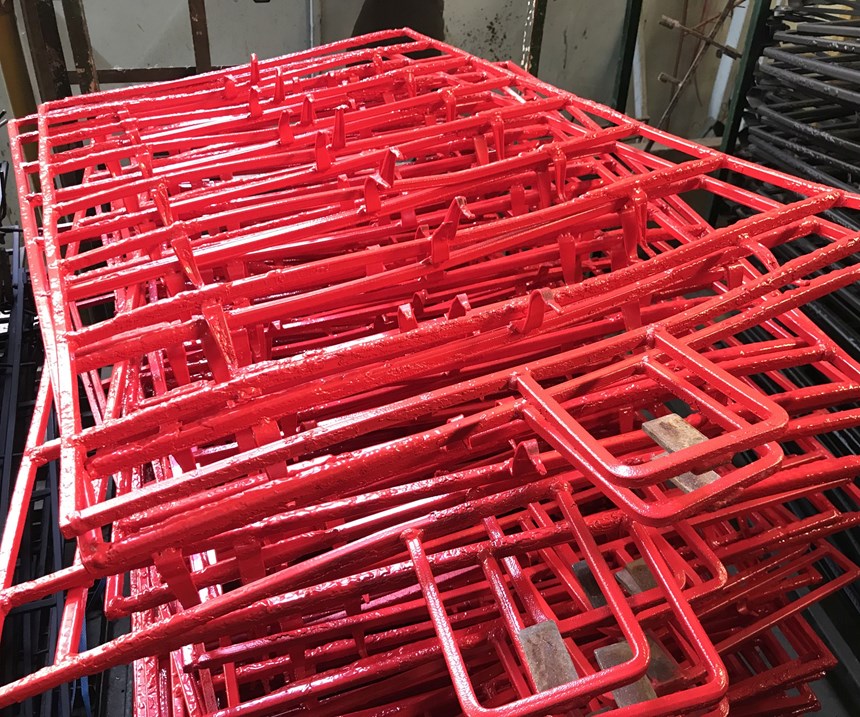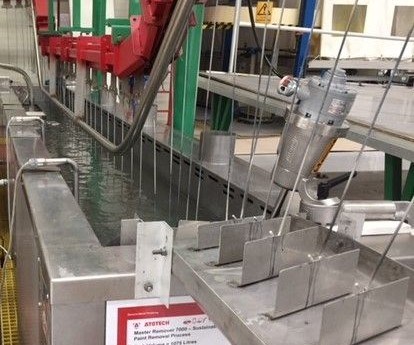Inline Removal of Paint from Racks and Fixtures
Appears in Print as: 'Inline and Off the Rack'
Atotech’s Master Remover 7000 makes inline removal of paint from racks and fixtures a fast and efficient possibility.
It's virtually inevitable in powder coating: Some parts will end up with surface defects. Sometimes those defects are caused by buildup of paint on racking or other fixtures that are holding them during the coating process. To minimize the risk of finished parts being rejected, it’s critical for a shop to clean its racking devices and fixtures frequently.
But what’s a coater to do while its racks are out of commission? Shut down the paint line and wait a few days for the fixtures it sent out for cleaning to be returned? Purchase an entire second set of fixtures that can be used in the meantime? Both can be costly and inefficient options.
Atotech has introduced an inline paint-removal process that’s specifically designed to rapidly remove powder paint from racks, hooks and other fixtures, minimizing downtime and the cost of buying additional fixtures. Master Remover 7000 is formulated to efficiently remove powder paint from a variety of substrates, eliminating the need for secondary offline cleaning with conventional paint-stripping processes.
“What is unique about the product, and what we haven’t seen on the market yet, is how fast it can remove powder coating,” says Sylvain Masson, global product manager. “Conventional processes can take hours to clean racks, and with this process, we are talking about minutes.”
Master Remover 7000 is a versatile process capable of operation in spray or immersion, as well as offline or inline applications. It also is easy to filter, which makes for long solution life, low waste and low maintenance, Masson says.
“We have a customer that has been running on the same solution for more than a year now,” he says. The customer had been having trouble with its previous paint-removal product, which would become so saturated with powder after just a few days that it would stop working effectively. The paint could not adequately be removed by the filter press, forcing the shop to trash the solution and remake it.
“Master Remover 7000 completely eliminates this problem,” Masson says. “The waste is significantly reduced, so they don’t have to trash the chemistry, they just have to dispose of the sludge.” And the sludge that is produced is dry, not wet, so it’s easier to remove, helping to minimize product consumption, he adds.
The non-aqueous paint removal process also is compatible with ferrous and light metals such as aluminum, zinc and magnesium, and offers advantages over conventional paint-removal processes, Masson says. It won’t damage or warp the substrate or produce incomplete paint removal, common drawbacks of mechanical methods. And unlike high-temperature thermal methods, Master Remover 7000 demands lower energy, operating at 140°F, and does not require subsequent ash removal and part cleaning. The paint remover also minimizes employee exposure to highly regulated and volatile organic compounds, characteristic detriments of conventional chemical methods.
According to Masson, few powder coating shops have considered inline removal of paint from racks and fixtures to be a viable option before; many outsource their paint removal or are doing some very elementary in-house stripping. “Master Remover 7000 is a much more sophisticated application that is safe for all fixture types and can save a lot of money,” he says.
To read more about the options for removing paint from racks and fixtures, visit short.pfonline.com/rackstrip.
Atotech USA LLC | Rock Hill, South Carolina | 803-817-3500 | atotech.com
RELATED CONTENT
-
Calculating Oven Heat Load Capacity
Please explain how to calculate the heat load capacity of a paint baking oven, using aluminum alloy wheels as an example.
-
Proper Testing of a Powder Coat Finish
Manufacturer shows how it performs extensive tests on powder coated medical carts.
-
Understanding Infrared Curing
Infrared cure is gaining increased attention from coaters as a result of shorter cure cycles and the possibility of smaller floor space requirements when compared to convection oven curing.


















